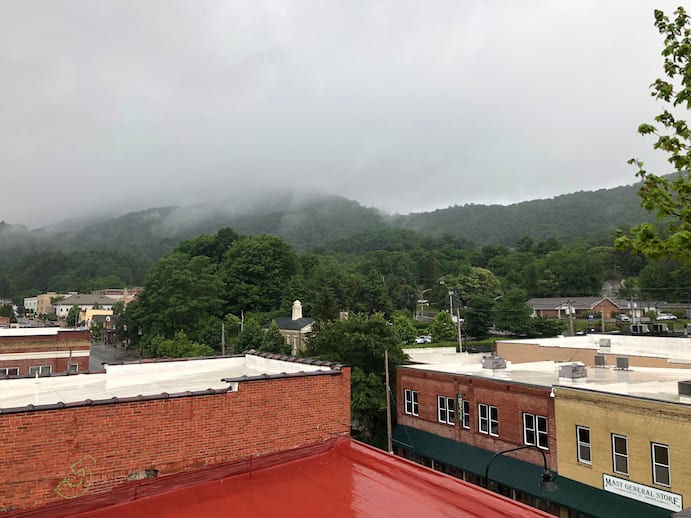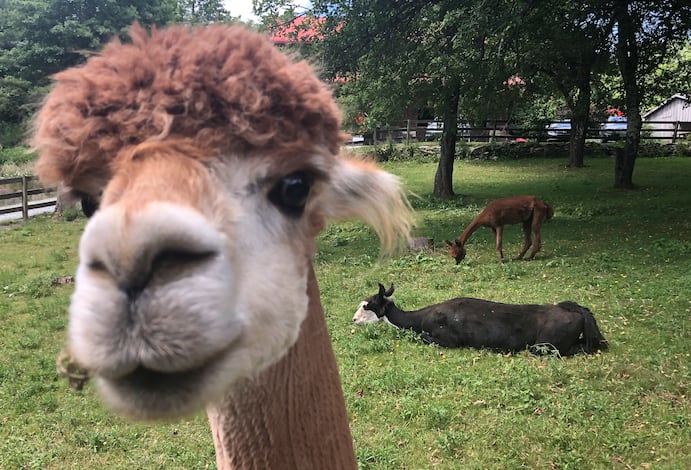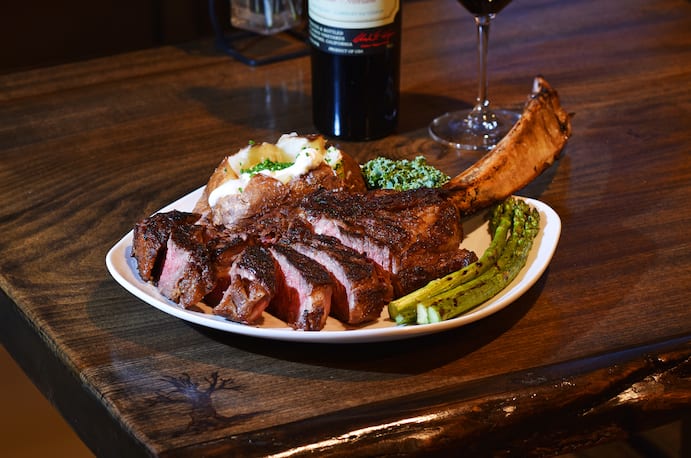It’s Sunday on the rooftop of the Horton Hotel in Boone, N.C., a college town in the Appalachian Mountains. The late-afternoon sun pops out briefly before hiding behind a chain of cotton clouds. I breathe deeply, audibly, and take in the clean mountain air.
In the distance, Howard’s Knob rises over town, as I scan the patio for my childhood friend, Kiffin, who is meeting me for a drink. A white-haired folk guitarist fingerpicks a few songs we know, as we catch up over Old Fashioneds and wine.
“You from this area?” the singer asks me, as I drop a few curled bills into the tip jar.

It’s my first visit back home since I moved from Charlotte to Columbus, Ohio, at the start of the coronavirus pandemic. After living a year largely limited to a new house in a new city in a new state, I feel a little like a hooked fish, finally tossed back into familiar waters.
North Carolina’s High Country is nestled in the Blue Ridge Mountains, in the northwest corner of the state, near the Tennessee and Virginia lines. The area includes scenic towns like Blowing Rock — a boutique-heavy place where shoppers stroll along Main Street, usually with an ice cream cone from Kilwin’s in hand — and Banner Elk, which impresses with its dining and theater scene, if you know where to look. Boone, named for frontiersman Daniel Boone, is the region’s largest town, anchored by Appalachian State University, where my brother attended college. He never really left.
“The mountains have a hold on you,” he always said.
The next morning, eager to hit the trails, I head south on Highway 321. Near Blowing Rock, I link up with the Blue Ridge Parkway, where the speed limit is 45 and the rolling countryside is untouched by time.
Following a trail of frescoes in the mountains of North Carolina
At Milepost 294, I stop at Moses H. Cone Memorial Park, once home to Gilded Age textile magnate Moses Cone and his wife, Bertha. In 1949, the family donated the estate to the National Park Service, and it’s still a popular pull-off for parkway travelers and outdoorsy locals alike.
In the side yard, a magenta bud peeks out from a perky rhododendron. It’s late June, so I may have just missed the full rush of the blooms, which this time of year blanket the landscape.

“Kind of amazing, sitting up here, looking out at all this creation,” a woman says to me from a bench. White pines, hemlocks and sugar maples fill the foreground. With a dip, they offer a generous panorama of the Blue Ridge Mountains in the distance. I ignore the clouds and set out toward Bass Lake below.
Unlike climbs with scenic rewards at the summit, from Cone Manor you can start at the top and zigzag down. Underfoot is a crunchy mix of gravel and dirt and pine straw, and with every hairpin, the air cools a degree or two. I happen upon a highland meadow, loaded with wildflowers and winged insects. A calm breeze picks up, and the treetops sway. Shhh. I want to wrap the air in a doggie bag and take it home for later.
Winding back up the trail, I reemerge into the late-morning sun. The clouds have surrendered, and it’s warm out. At the manor — which is being restored, but you can still go in — I find the Southern Highland Craft Guild shop. Inside, shelves display regional goods like hand-carved wooden bowls and busy little corn-husk dolls who hold miniature umbrellas and baskets and babies. Beadwork bracelets lie flat, snakelike, in a case of handmade jewelry. Around the corner, Blenko bottles — turquoise, garnet, tangerine — line a ledge in a second room, packed with North Carolina pottery.
A little dewy, I make the roughly 25-minute drive back to the Horton to freshen up.
The 15-room boutique, run by locals Fulton and Denise Lovin, is a place of makers. Exposed brick from the hotel’s first life as a Studebaker dealership meets modern furniture and sinuous, carved wood. In my third-floor room, I find lemongrass lotion made in nearby Valle Crucis, and chocolates whose sales benefit Wine to Water, a Boone-based nonprofit that cleans up water all over the world.
Outside on King Street, the Mast General Store stocks outdoor gear and country-store nostalgia. Its original Valle Crucis location, about 15 minutes away, dates to 1883, and includes an annex store, where candy barrels burst with Charleston Chews and black licorice and little wax bottles with juice inside.
I would like to keep browsing, but I’m due for a meeting in Banner Elk in a half-hour.

High in the hills, I find a working alpaca farm that offers public tours. I park along a fence by the animals, and Apple Hill Farm owner Lee Rankin guides me to a shaded spot where two sparky farm dogs yap and circle our shins.
In 2000, Rankin took her son to the Kentucky State Fair, where she met a long-necked, docile creature. “I looked into the eye of this alpaca,” she said. “I fell in love.” She moved to the mountains the next year, and she started raising her own. After a devastating attack on the herd, “people started hearing the story in town about the lady up on the hill that had the mountain lion attack on the alpacas,” she said. “People would just drive up.”
The farm is home to four llamas, 20 alpacas, 25 angora goats, seven donkeys (they guard the livestock), two horses, a couple of zebu, plus pigs and chickens. In the shop, yarn comes in a crayon box of colors. Alpaca-fiber socks, gloves and dryer balls are all for sale.
“People are still hungry for getting back to the basics,” Rankin said. “Everyone who comes here doesn’t want to go home.”
Rambling around a mountain farm is tough work, and my stomach tells me it’s almost time to eat.
For dinner, I head to Stonewalls, a downtown Banner Elk staple. Co-owner Scott Garland, a native of neighboring Linville, attended his senior prom here in 1986, well before he owned the place.
In 2016, he and his partner, Tim Heschke, bought the restaurant and updated the interior and the menu. “I spent my first 18 years trying to get the hell outta here,” Garland said, “and the last 30 years trying to get back.”
The mountains have that effect.
The last time I ate here was in October 2019, the day I exchanged vows with my husband. By late afternoon, the town park was packed for the Woolly Worm Festival, a fall favorite, where locals and visitors weave through tents of crafts, wielding roasted turkey legs and corn dogs. Fuzzy black-and-brown striped caterpillars clench long strings and inch up race boards. The fastest worm wins.

I order a glass of pinot noir and mull over the menu. Stonewalls is known for its prime rib. “It goes in at 9 a.m., and it slow-roasts all day long,” Garland told me earlier. “We have a special oven that controls the humidity and the temperature.” They also dry-age their rib-eyes in house for 21 days.
Steaks aren’t the only draw. “One of my favorite things on the menu is the beer-battered fish and chips,” Garland admitted. Heschke makes the PBR batter fresh daily, and it fries up nice and crispy. He also likes the Duroc pork chop.
My prime rib arrives medium-rare, with a trio of toppings in little cups: au jus, a horseradish cream sauce and another, thicker horseradish dip. “A little salt, a little pepper and that au jus . . . ” the bartender ends the sentence with a nod and hand gesture: perfection.
The next morning, a gauzy fog floats over Howard’s Knob. King Street is wet. In a steady drizzle, I drive to the outskirts of town to meet Shauna Godwin, artistic director of the 69-years-running outdoor drama, “Horn in the West.”
The play tells the story of a British doctor who flees England to the local region with his family during the Revolutionary War. “His wife thinks the area is magical, and eventually, he falls in love with it and ends up staying,” Godwin explained.
Friday marks her first show as director, the first since the covid pandemic prevented last year’s season. Godwin grew up in Boone and went to high school here. In 2003, she joined the company as a dancer, then moved to New York City. In 2014, she came home. “It’s the Boone-erang,” she said. “I don’t know if that’s a thing, but that’s what I call it.”
The mountains have a hold on you.
As I load my car, I consider all that fills this corner of home with such comfort. Fuzzy animals and kindness. Cool, quiet hikes. Prize-worthy prime rib. The perspective of the Blue Ridge.
Raindrops splat against my windshield as I start out on Highway 421. I lower my window, fill my lungs with the damp mountain air and try to commit it to memory. I suck in one more breath, blow it out slowly and head north.
The original version of this story ran in The Washington Post on July 16, 2021.

